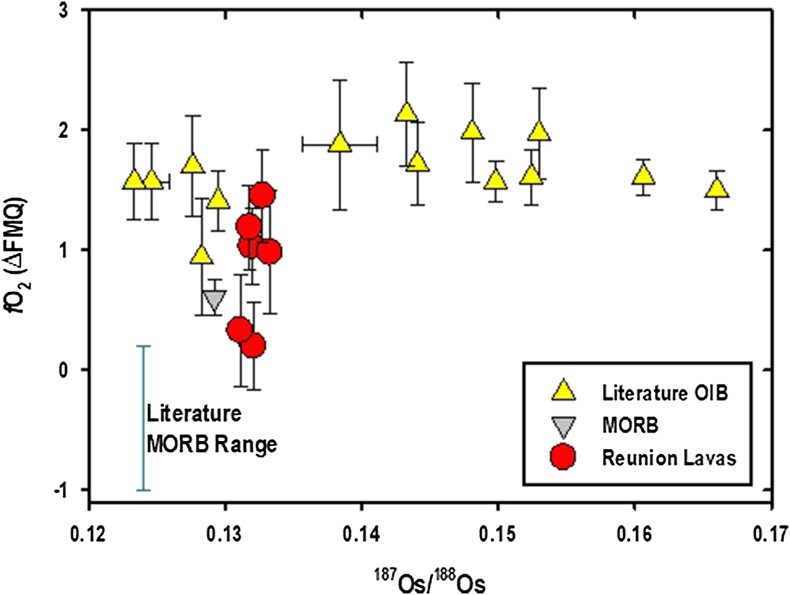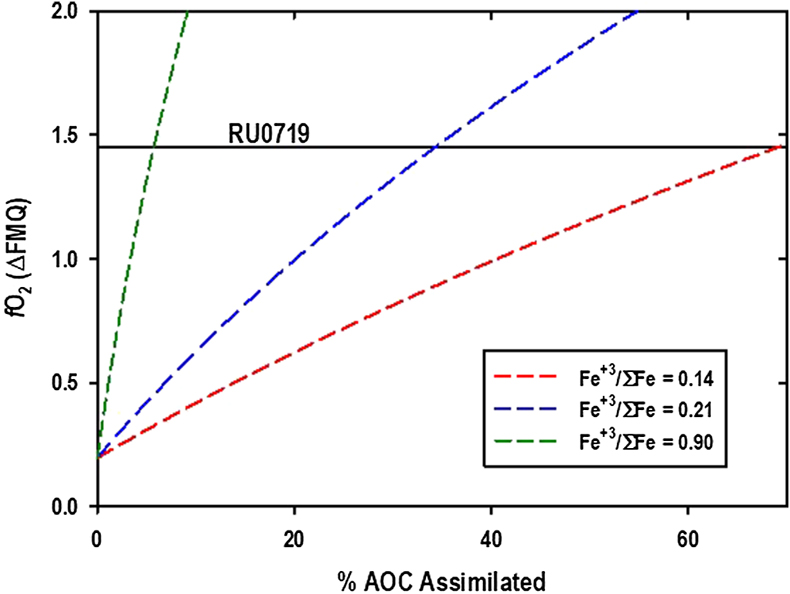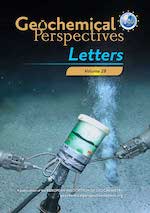Oxidation of La Réunion lavas with MORB-like fO2 by assimilation
Affiliations | Corresponding Author | Cite as | Funding information- Share this article





-
Article views:2,198Cumulative count of HTML views and PDF downloads.
- Download Citation
- Rights & Permissions
top
Abstract

Figures and Tables
 Figure 1 Average V concentrations in olivine cores plotted against forsterite number (from Peters et al., 2016), along with olivine from a Tonga Trench forearc peridotite, MORB olivine (Nicklas et al., 2019), and olivine from other OIBs (Nicklas et al., 2021). |  Figure 2 Oxygen fugacity plotted against bulk rock 187Os/188Os. Literature OIB data from Nicklas et al. (2019, 2021). The MORB estimate using V in olivine oxybarometry (Nicklas et al., 2019) is shown as an inverted triangle. Also plotted is the range of MORB oxygen fugacity estimates using other oxybarometry methods as “Literature MORB Range” (Li and Lee 2004; Berry et al., 2018; Zhang et al., 2018; Novella et al., 2020). |  Figure 3 Results of mixing calculations between a parental magma composition of RU0702 and an Fe+3/ΣFe of 0.071 and an altered basalt with the same composition but Fe+3/ΣFe values of 0.14, 0.21 and 0.90. Oxygen fugacity was calculated assuming bulk mixing, the calibration of Kress and Carmichael (1991), and a temperature of 1200 °C. Horizontal dashed line represents the maximum measured Réunion lava fO2 of +1.45 ΔFMQ. |  Table 1 Parental magma compositions; oxides are in wt. %, V is in ppm (∼10 % uncertainty). Average ppm V in olivine is also listed. NBO/T – non-bonding oxygens divided by tetrahedrally bonded oxygens in each parental melt. ΔFMQ – oxygen fugacity relative to FMQ buffer. Up – positive uncertainty, down – negative uncertainty. 187Os/188Os are bulk rock values (Peters et al., 2016). Ol add/subtract – the amount of olivine added or subtracted from the bulk rock composition to calculate the parental magma composition. Positive percentages are added olivine, negative percentages are subtracted olivine. Temperature is calculated using the formulation of Nisbet et al. (1993). |
| Figure 1 | Figure 2 | Figure 3 | Table 1 |
top
Introduction
Oxygen fugacity (fO2) of primitive lavas is a proxy for the fO2 of their mantle sources and is useful for constraining mantle redox variability (Carmichael, 1991
Carmichael, I.S. (1991) The redox states of basic and silicic magmas: A reflection of their source regions? Contributions to Mineralogy and Petrology 106, 129–141.
; Moussallam et al., 2019Moussallam, Y., Longpre, M.-A., McCammon, C., Gomez-Ulla, A., Rose-Koga, E.F., Scaillet, B., Peters, N., Gennero, E., Paris, R., Oppenheimer, C. (2019) Mantle Plumes are oxidized. Earth and Planetary Science Letters 527, 115798.
; Nicklas et al., 2021Nicklas, R.W., Hahn, R.K.M., Willhite, L.N., Jackson, M.G., Zanon, V., Arevalo Jr., A., Day, J.M.D. (2021) Oxidized Mantle Sources of HIMU and EM-type Ocean Island Basalts. Earth Arxiv (pre-print). https://doi.org/10.31223/X5D051.
). Redox constraints are important for testing models of recycling into the deep Earth, as well as for tracking mantle differentiation and mixing (Carmichael, 1991Carmichael, I.S. (1991) The redox states of basic and silicic magmas: A reflection of their source regions? Contributions to Mineralogy and Petrology 106, 129–141.
; Frost et al., 2008Frost, D.J., Mann, U., Asahara, Y., Rubie, D.C. (2008) The redox state of the mantle during and after core formation. Philosophical Transactions of the Royal Society A 366, 4315–4337.
; Brounce et al., 2017Brounce, M.N., Stolper, E., Eiler, J. (2017) Redox variations in Mauna Kea lavas, the oxygen fugacity of the Hawaiian plume, and the role of volcanic gases in Earth’s oxygenation. Proceedings of the National Academy of Sciences 114, 8997–9002.
). While fO2 in primitive melts can be modified by processes such as fractional crystallisation (Kelley and Cottrell, 2012Kelley, K.A., Cottrell, E. (2012) The influence of magmatic differentiation on the oxidation state of Fe in a basaltic arc magma. Earth Planetary and Science Letters 329–330, 109–121.
), crustal contamination (Grocke et al., 2016Grocke, S.B., Cottrell, E., Silva, S.D., Kelley, K.A. (2016) The role of crustal and eruptive processes versus source variations in controlling the oxidation state of iron in Central Andean magmas. Earth and Planetary Science Letters 440, 92–104.
) and degassing (Moussallam et al., 2019Moussallam, Y., Longpre, M.-A., McCammon, C., Gomez-Ulla, A., Rose-Koga, E.F., Scaillet, B., Peters, N., Gennero, E., Paris, R., Oppenheimer, C. (2019) Mantle Plumes are oxidized. Earth and Planetary Science Letters 527, 115798.
), the fO2 of erupted basalts is, to a first order, controlled by the fO2 of their mantle source (Birner et al., 2018Birner, S.K., Cottrell, E., Warren, J.E., Kelley, K.A., Davis, F.A. (2018) Peridotites and basalts reveal broad congruence between two independent records of mantle fO2 despite local redox heterogeneity. Earth and Planetary Science Letters 494, 172–189.
). Oxygen fugacity varies strongly with tectonic environment (Carmichael, 1991Carmichael, I.S. (1991) The redox states of basic and silicic magmas: A reflection of their source regions? Contributions to Mineralogy and Petrology 106, 129–141.
), as arc basalts (ΔFMQ ≥ +2) have elevated fO2 relative to mid-ocean ridge basalts (ΔFMQ ≈ 0), possibly due to metasomatism of the mantle wedge by oxidised recycled materials (Kelley and Cottrell, 2012Kelley, K.A., Cottrell, E. (2012) The influence of magmatic differentiation on the oxidation state of Fe in a basaltic arc magma. Earth Planetary and Science Letters 329–330, 109–121.
), or due to distinct differentiation processes (Tang et al., 2018Tang, M., Erdman, M., Eldridge, G., Lee, C.-T.A. (2018) The redox “filter” beneath magmatic orogens and the formation of continental crust. Science Advances 4, eaar4444.
). Global mass balance calculations show, however, that ∼90 % of oxidants are not returned in arc volcanism and are instead taken into the deep mantle (Evans, 2012Evans, K.A. (2012) The redox budget of subduction zones. Earth Science Reviews 113, 11–32.
). Ocean island basalts are the result of melting in deep-seated plumes that contain a variety of recycled crustal lithologies (e.g., Hofmann, 1997Hofmann, A.W. (1997) Mantle geochemistry: the message from oceanic volcanism. Nature 385, 219–229.
), and so are expected to contain some of these recycled oxidants, of which Fe+3 is the most important (Evans, 2012Evans, K.A. (2012) The redox budget of subduction zones. Earth Science Reviews 113, 11–32.
).Compared to arc lavas and MORB, OIB fO2 is not as comprehensively documented. This is partly due to the general absence of glassy materials for X-ray near edge absorption spectroscopy (XANES) measurements meaning that alternative oxybarometry methods are required. It has recently been suggested that OIBs could be equally or even more oxidised than arc lavas (Moussallam et al., 2019
Moussallam, Y., Longpre, M.-A., McCammon, C., Gomez-Ulla, A., Rose-Koga, E.F., Scaillet, B., Peters, N., Gennero, E., Paris, R., Oppenheimer, C. (2019) Mantle Plumes are oxidized. Earth and Planetary Science Letters 527, 115798.
), possibly resulting from sampling oxidised altered oceanic crust (AOC). Sulfur degassing of OIB melts can also have a variable and large (∼2 log units) effect on the fO2 measured in glasses and melt inclusions (Moussallam et al., 2019Moussallam, Y., Longpre, M.-A., McCammon, C., Gomez-Ulla, A., Rose-Koga, E.F., Scaillet, B., Peters, N., Gennero, E., Paris, R., Oppenheimer, C. (2019) Mantle Plumes are oxidized. Earth and Planetary Science Letters 527, 115798.
), making some OIBs appear to be as reduced as MORBs. In contrast with XANES, the V in olivine oxybarometry method records fO2 as a melt crystallises olivine, which may occur prior to significant sulfur degassing (Nicklas et al., 2021Nicklas, R.W., Hahn, R.K.M., Willhite, L.N., Jackson, M.G., Zanon, V., Arevalo Jr., A., Day, J.M.D. (2021) Oxidized Mantle Sources of HIMU and EM-type Ocean Island Basalts. Earth Arxiv (pre-print). https://doi.org/10.31223/X5D051.
).In this study, fO2 is measured in lavas from the La Réunion hotspot. Réunion is an island in the south Indian Ocean composed of two major volcanos including the currently active Piton de la Fournaise (Albarede et al., 1997
Albarede, F., Luais, B., Fitton, G., Semet, M., Kaminski, E., Upton, B.G.J., Bachelery, P., Cheminee, J.L. (1997) The geochemical regimes of Piton de la Fournaise volcano (Réunion) during the last 530,000 years. Journal of Petrology 38, 171–201.
). Lavas from Réunion are remarkable for their uniform He, Nd, Os and Pb isotope signatures, with elevated 3He/4He and primitive mantle like Pb isotopes suggesting an ancient deep mantle source (Vlastelic et al., 2006Vlastelic, I., Lewin, E., Staudacher, T. (2006) Th/U and other geochemical evidence for the Réunion plume sampling a less differentiated mantle domain. Earth and Planetary Science Letters 248, 379–393.
; Füri et al., 2011Füri, E., Hilton, D.R., Murton, B.J., Hemond, C., Dyment, J., Day, J.M.D. (2011). Helium isotope variations between Réunion Island and the Central Indian Ridge (17°–21°S): New evidence for ridge-hot spot interaction. Journal of Geophysical Research 106, B02207.
; Peters et al., 2016Peters, B.J., Day, J.M.D., Taylor, L.A. (2016) Early mantle heterogeneities in the Réunion hotspot source inferred from highly siderophile elements in cumulate xenoliths. Earth and Planetary Science Letters 448, 150–160.
). Réunion lavas have elevated 3He/4He ratios (up to ∼14 RA; Füri et al., 2011Füri, E., Hilton, D.R., Murton, B.J., Hemond, C., Dyment, J., Day, J.M.D. (2011). Helium isotope variations between Réunion Island and the Central Indian Ridge (17°–21°S): New evidence for ridge-hot spot interaction. Journal of Geophysical Research 106, B02207.
) and are little influenced by recycled AOC, so Réunion is a key locality at which to characterise fO2.top
Methods and Results
The sample set includes seven Réunion olivine-rich lavas, which have been characterised for their bulk rock geochemistry previously (Peters et al., 2016
Peters, B.J., Day, J.M.D., Taylor, L.A. (2016) Early mantle heterogeneities in the Réunion hotspot source inferred from highly siderophile elements in cumulate xenoliths. Earth and Planetary Science Letters 448, 150–160.
). Laser ablation inductively coupled plasma mass spectrometry (LA-ICP-MS) analyses of cores of olivine were performed for 24–36 grains in each sample (Supplementary Information; average olivine trace element concentrations are reported in Table S-1). The V content of the calculated parental melt for each sample was coupled with the V content in olivine to calculate DVolivine/melt of each sample. Calculated DVolivine/melt and temperature (Nisbet et al., 1993Nisbet, E.G., Cheadle, M.J., Arndt, N.T., Bickle, M.J. (1993) Constraining the potential temperature of the Archaean mantle: A review of the evidence from komatiites. Lithos 30, 291–307.
) were then used with the empirical equation of Wang et al. (2019)Wang, J., Xiong, X., Takahashi, E., Zhang, L., Li, L., Liu, X. (2019) Oxidation State of Arc Mantle Revealed by Partitioning of V, Sc and Ti Between Mantle Minerals and Basaltic Melts. Journal of Geophysical Research: Solid Earth 124, 4617–4638.
to compute the fO2 for each lava. Parental magma major element and V concentrations and oxygen fugacities are listed in Table 1; calculation details are in the Supplementary Information. Reported uncertainties of fO2 values are based on the uncertainties of V concentrations in olivine and parental lavas, as temperature and parental magma major element composition have only a second order effect on the reported fO2. Vanadium concentrations in olivine vary between 6.0 ± 1.3 and 8.6 ± 2.1 ppm. Also analysed as a proxy for depleted ocean lithosphere olivine was a depleted harzburgite from the Tonga Trench (Day and Brown, 2021Day, J.M.D., Brown, D.B. (2021) Ancient melt-depletion in fresh to strongly serpentinized Tonga Trench peridotites. Journal of Petrology 62, egab088.
), with olivine containing 0.7 ± 0.2 ppm V.Table 1 Parental magma compositions; oxides are in wt. %, V is in ppm (∼10 % uncertainty). Average ppm V in olivine is also listed. NBO/T – non-bonding oxygens divided by tetrahedrally bonded oxygens in each parental melt. ΔFMQ – oxygen fugacity relative to FMQ buffer. Up – positive uncertainty, down – negative uncertainty. 187Os/188Os are bulk rock values (Peters et al., 2016
Peters, B.J., Day, J.M.D., Taylor, L.A. (2016) Early mantle heterogeneities in the Réunion hotspot source inferred from highly siderophile elements in cumulate xenoliths. Earth and Planetary Science Letters 448, 150–160.
). Ol add/subtract – the amount of olivine added or subtracted from the bulk rock composition to calculate the parental magma composition. Positive percentages are added olivine, negative percentages are subtracted olivine. Temperature is calculated using the formulation of Nisbet et al. (1993)Nisbet, E.G., Cheadle, M.J., Arndt, N.T., Bickle, M.J. (1993) Constraining the potential temperature of the Archaean mantle: A review of the evidence from komatiites. Lithos 30, 291–307.
.| Sample Name | RU0702 | RU0703 | RU0705 | RU0707 | RU0709 | RU0715 | RU0719 |
| SiO2 | 46.3 | 48.6 | 46.3 | 49.1 | 47.2 | 48.3 | 46.4 |
| TiO2 | 2.35 | 2.46 | 2.42 | 2.35 | 2.48 | 2.13 | 2.40 |
| Al2O3 | 12.4 | 12.9 | 12.3 | 12.8 | 12.5 | 12.4 | 12.4 |
| FeO | 13.1 | 11.4 | 13.1 | 11.2 | 11.9 | 12.0 | 12.8 |
| MnO | 0.19 | 0.17 | 0.20 | 0.17 | 0.18 | 0.19 | 0.18 |
| MgO | 12.7 | 11.1 | 13.2 | 11.0 | 11.6 | 11.7 | 12.5 |
| CaO | 10.0 | 10.0 | 9.7 | 10.1 | 10.8 | 10.0 | 10.2 |
| Na2O | 2.03 | 2.39 | 2.10 | 2.37 | 2.23 | 2.37 | 2.15 |
| K2O | 0.59 | 0.66 | 0.52 | 0.60 | 0.72 | 0.68 | 0.65 |
| P2O5 | 0.27 | 0.29 | 0.28 | 0.28 | 0.29 | 0.29 | 0.28 |
| V (ppm) | 163 | 139 | 294 | 263 | 315 | 283 | 313 |
| NBO/T | 1.14 | 0.97 | 1.16 | 0.96 | 1.07 | 1.04 | 1.13 |
| Olivine V (ppm) | 6.49 | 5.96 | 6.94 | 6.83 | 8.55 | 6.66 | 6.00 |
| 2 s.d. | 1.06 | 1.32 | 1.00 | 1.07 | 2.06 | 0.79 | 1.05 |
| ΔFMQ | 0.20 | 0.33 | 1.03 | 1.19 | 0.98 | 1.24 | 1.45 |
| Up | 0.36 | 0.47 | 0.32 | 0.35 | 0.51 | 0.28 | 0.38 |
| Down | 0.29 | 0.37 | 0.27 | 0.29 | 0.39 | 0.24 | 0.31 |
| Temperature (°C) | 1255 | 1221 | 1264 | 1220 | 1233 | 1233 | 1250 |
| 187 Os/188 Os | 0.13205 | 0.13110 | 0.13194 | 0.13179 | 0.13328 | 0.13273 | |
| 2 s.e. | 0.00007 | 0.00024 | 0.00006 | 0.00028 | 0.00013 | 0.00013 | |
| Ol add/subtract | −37.7 % | +10.7 % | −50.4 % | +11.3 % | +1.4 % | +2.0 % | +28.1 % |
Réunion olivine shows a broader range in V content than other OIB olivines (Fig. 1). The fO2 of the lavas show wide variation, between +0.20+0.36−0.29 and +1.45+0.38−0.31 ΔFMQ, and do not correlate with parental magma composition. The fO2 values range between MORB at +0.60 ± 0.15 (Nicklas et al., 2019
Nicklas, R.W., Puchtel, I.S., Ash, R.D., Piccoli, P.M., Hanski, E., Nisbet, E.G., Waterton, P.M., Pearson, D.G., Anbar, A.D. (2019) Secular Mantle Oxidation across the Archean-Proterozoic Boundary: Evidence from V Partitioning in Komatiites and Picrites. Geochimica et Cosmochimica Acta 250, 49–75.
) and the global OIB average at +1.7 ± 0.8 ΔFMQ, both measured using the same oxybarometry method (Nicklas et al., 2021Nicklas, R.W., Hahn, R.K.M., Willhite, L.N., Jackson, M.G., Zanon, V., Arevalo Jr., A., Day, J.M.D. (2021) Oxidized Mantle Sources of HIMU and EM-type Ocean Island Basalts. Earth Arxiv (pre-print). https://doi.org/10.31223/X5D051.
). The Réunion lavas also overlap with MORB fO2 estimates obtained by other oxybarometry methods (Li and Lee, 2004Li, Z.-X.A., Lee, C.-T.A. (2004) The constancy of upper mantle fO2 through time inferred from V/Sc ratios in basalts. Earth and Planetary Science Letters 228, 483–493.
; Berry et al., 2018Berry, A.J., Stewart, G.A., O’Neill, H.St.C., Mallmann, G., Mosselmans, J.F.W. (2018) A re-assesment of the oxidation state of iron in MORB glasses. Earth and Planetary Science Letters 483, 144–123.
; Zhang et al., 2018Zhang, H.L., Cottrell, E., Solheid, P.A., Kelley, K.A., Hirschmann, M.M. (2018). Determination of Fe+3/ΣFe of XANES basaltic glass standards by Mossbauer spectroscopy and its application to the oxidation state of iron in MORB. Chemical Geology 479, 166–175.
; Wang et al., 2019Wang, J., Xiong, X., Takahashi, E., Zhang, L., Li, L., Liu, X. (2019) Oxidation State of Arc Mantle Revealed by Partitioning of V, Sc and Ti Between Mantle Minerals and Basaltic Melts. Journal of Geophysical Research: Solid Earth 124, 4617–4638.
; Novella et al., 2020Novella, D., Maclennan, J., Shorttle, O., Prytulak, J., Murton, B.J. (2020) A multi-proxy investigation of mantle oxygen fugacity along the Reykjanes Ridge. Earth and Planetary Science Letters 531, 115973.
). The V in olivine method assumes that the measured olivine is either phenocrystic or antecrystic, and that olivine has not been diffusively reset since crystallisation (see discussion in Supplementary Information). In short, although the studied olivine grains cannot conclusively be shown to be ubiquitously phenocrysts or antecrysts, it is unlikely that samples such as RU0705 (∼49 % modal olivine; Peters et al., 2016Peters, B.J., Day, J.M.D., Taylor, L.A. (2016) Early mantle heterogeneities in the Réunion hotspot source inferred from highly siderophile elements in cumulate xenoliths. Earth and Planetary Science Letters 448, 150–160.
) would have assimilated such high quantities of unrelated olivine. The pervasively high 3He/4He measured in olivine separates from these lavas (Füri et al., 2011Füri, E., Hilton, D.R., Murton, B.J., Hemond, C., Dyment, J., Day, J.M.D. (2011). Helium isotope variations between Réunion Island and the Central Indian Ridge (17°–21°S): New evidence for ridge-hot spot interaction. Journal of Geophysical Research 106, B02207.
) strongly suggests that the olivine grains ultimately originate from recent Réunion magmas reinforcing the concept that the calculated fO2 variations relate to assimilation processes, rather than reflecting mantle source variations.
Figure 1 Average V concentrations in olivine cores plotted against forsterite number (from Peters et al., 2016
Peters, B.J., Day, J.M.D., Taylor, L.A. (2016) Early mantle heterogeneities in the Réunion hotspot source inferred from highly siderophile elements in cumulate xenoliths. Earth and Planetary Science Letters 448, 150–160.
), along with olivine from a Tonga Trench forearc peridotite, MORB olivine (Nicklas et al., 2019Nicklas, R.W., Puchtel, I.S., Ash, R.D., Piccoli, P.M., Hanski, E., Nisbet, E.G., Waterton, P.M., Pearson, D.G., Anbar, A.D. (2019) Secular Mantle Oxidation across the Archean-Proterozoic Boundary: Evidence from V Partitioning in Komatiites and Picrites. Geochimica et Cosmochimica Acta 250, 49–75.
), and olivine from other OIBs (Nicklas et al., 2021Nicklas, R.W., Hahn, R.K.M., Willhite, L.N., Jackson, M.G., Zanon, V., Arevalo Jr., A., Day, J.M.D. (2021) Oxidized Mantle Sources of HIMU and EM-type Ocean Island Basalts. Earth Arxiv (pre-print). https://doi.org/10.31223/X5D051.
).top
Oxygen Fugacity of Réunion Lavas
The calculated fO2 of Réunion lavas is highly variable compared with other OIBs (Fig. 2). The more reduced Réunion lavas overlap with the MORB range, unlike other OIBs. The variability of the data is unanticipated given the limited range of isotopic compositions suggesting a homogenous mantle source (Albarede et al., 1997
Albarede, F., Luais, B., Fitton, G., Semet, M., Kaminski, E., Upton, B.G.J., Bachelery, P., Cheminee, J.L. (1997) The geochemical regimes of Piton de la Fournaise volcano (Réunion) during the last 530,000 years. Journal of Petrology 38, 171–201.
; Vlastelic et al., 2006Vlastelic, I., Lewin, E., Staudacher, T. (2006) Th/U and other geochemical evidence for the Réunion plume sampling a less differentiated mantle domain. Earth and Planetary Science Letters 248, 379–393.
; Peters et al., 2016Peters, B.J., Day, J.M.D., Taylor, L.A. (2016) Early mantle heterogeneities in the Réunion hotspot source inferred from highly siderophile elements in cumulate xenoliths. Earth and Planetary Science Letters 448, 150–160.
). A possibility that can be precluded to explain the variations in fO2 is variable amounts of recycled AOC in the plume, due to the uniform and unradiogenic Pb and Os isotope signatures of lavas (Vlastelic et al., 2006Vlastelic, I., Lewin, E., Staudacher, T. (2006) Th/U and other geochemical evidence for the Réunion plume sampling a less differentiated mantle domain. Earth and Planetary Science Letters 248, 379–393.
; Peters et al., 2016Peters, B.J., Day, J.M.D., Taylor, L.A. (2016) Early mantle heterogeneities in the Réunion hotspot source inferred from highly siderophile elements in cumulate xenoliths. Earth and Planetary Science Letters 448, 150–160.
). Alternatively, the most oxidised Réunion lava (RU0719 at +1.5 ΔFMQ) may be representative of the plume with the other lavas being reduced by degassing of SO2. Sulfur degassing can lead to reduction of a melt (Moussallam et al., 2019Moussallam, Y., Longpre, M.-A., McCammon, C., Gomez-Ulla, A., Rose-Koga, E.F., Scaillet, B., Peters, N., Gennero, E., Paris, R., Oppenheimer, C. (2019) Mantle Plumes are oxidized. Earth and Planetary Science Letters 527, 115798.
), with loss of ∼4000 ppm S from Canary and Cape Verde OIBs leading to a ∼2.5 log unit fO2 reduction. Réunion lavas have been estimated to having degassed at most 1510 ppm S, but likely only 100 ppm (Bureau et al., 1998Bureau, H., Metrich, N., Pineau, F., Semet, M.P. (1998) Magma-conduit interaction at Piton de la Fournaise volcano (Reunion Island): a melt and fluid inclusion study. Journal of Volcanology and Geothermal Research 84, 39–60.
; Collins et al., 2012Collins, S.J., Maclennan, J., Pyle, D.M., Barnes, S.J., Upton, B.G.J. (2012) Two phases of sulfide saturation in Réunion magmas: Evidence from cumulates. Earth and Planetary Science Letters 337–338, 104–113.
). If S degassing has a similar redox effect for Réunion lavas as it does in other OIBs, even maximum loss of 1510 ppm S would cause only a 1.05 log unit reduction in fO2, smaller than the range of the data even in this most extreme case. For this reason, S degassing can only explain part of the fO2 variations, assuming that such degassing took place during olivine crystallisation.
Figure 2 Oxygen fugacity plotted against bulk rock 187Os/188Os. Literature OIB data from Nicklas et al. (2019
Nicklas, R.W., Puchtel, I.S., Ash, R.D., Piccoli, P.M., Hanski, E., Nisbet, E.G., Waterton, P.M., Pearson, D.G., Anbar, A.D. (2019) Secular Mantle Oxidation across the Archean-Proterozoic Boundary: Evidence from V Partitioning in Komatiites and Picrites. Geochimica et Cosmochimica Acta 250, 49–75.
, 2021Nicklas, R.W., Hahn, R.K.M., Willhite, L.N., Jackson, M.G., Zanon, V., Arevalo Jr., A., Day, J.M.D. (2021) Oxidized Mantle Sources of HIMU and EM-type Ocean Island Basalts. Earth Arxiv (pre-print). https://doi.org/10.31223/X5D051.
). The MORB estimate using V in olivine oxybarometry (Nicklas et al., 2019Nicklas, R.W., Puchtel, I.S., Ash, R.D., Piccoli, P.M., Hanski, E., Nisbet, E.G., Waterton, P.M., Pearson, D.G., Anbar, A.D. (2019) Secular Mantle Oxidation across the Archean-Proterozoic Boundary: Evidence from V Partitioning in Komatiites and Picrites. Geochimica et Cosmochimica Acta 250, 49–75.
) is shown as an inverted triangle. Also plotted is the range of MORB oxygen fugacity estimates using other oxybarometry methods as “Literature MORB Range” (Li and Lee 2004Li, Z.-X.A., Lee, C.-T.A. (2004) The constancy of upper mantle fO2 through time inferred from V/Sc ratios in basalts. Earth and Planetary Science Letters 228, 483–493.
; Berry et al., 2018Berry, A.J., Stewart, G.A., O’Neill, H.St.C., Mallmann, G., Mosselmans, J.F.W. (2018) A re-assesment of the oxidation state of iron in MORB glasses. Earth and Planetary Science Letters 483, 144–123.
; Zhang et al., 2018Zhang, H.L., Cottrell, E., Solheid, P.A., Kelley, K.A., Hirschmann, M.M. (2018). Determination of Fe+3/ΣFe of XANES basaltic glass standards by Mossbauer spectroscopy and its application to the oxidation state of iron in MORB. Chemical Geology 479, 166–175.
; Novella et al., 2020Novella, D., Maclennan, J., Shorttle, O., Prytulak, J., Murton, B.J. (2020) A multi-proxy investigation of mantle oxygen fugacity along the Reykjanes Ridge. Earth and Planetary Science Letters 531, 115973.
).Assimilation of material from within the volcanic edifice is a well known phenomenon in OIB. For Réunion, if the lavas were to assimilate altered and oxidised basaltic material, then radiogenic isotope modification from such assimilation would be minimal due to the young age of Piton de la Fournaise. The whole rock dataset of Peters et al. (2016)
Peters, B.J., Day, J.M.D., Taylor, L.A. (2016) Early mantle heterogeneities in the Réunion hotspot source inferred from highly siderophile elements in cumulate xenoliths. Earth and Planetary Science Letters 448, 150–160.
includes concentrations of both ferrous and ferric iron, with Fe+3/ΣFe ratios varying between 0.03 and 0.90, ranging significantly higher than mantle derived basalts at <0.3 (Moussallam et al., 2019Moussallam, Y., Longpre, M.-A., McCammon, C., Gomez-Ulla, A., Rose-Koga, E.F., Scaillet, B., Peters, N., Gennero, E., Paris, R., Oppenheimer, C. (2019) Mantle Plumes are oxidized. Earth and Planetary Science Letters 527, 115798.
), indicating that many of the basalts have suffered oxidative alteration. Starting from the lowest fO2 Réunion sample (+0.2 ΔFMQ) and using Fe+3/ΣFe ratios of 0.14, 0.21, and 0.90, mixing calculations were performed to determine the amount of assimilation needed to oxidise RU0702 to +1.5 ΔFMQ (Fig. 3). This modelling shows that 35 % to 5 % edifice assimilation would be required to explain the range in data if assimilated materials had Fe+3/ΣFe = 0.21 and 0.90, respectively. Although 5 % assimilation is reasonable for a high MgO magma, 35 % assimilation will spur extensive fractional crystallisation from cooling and could not plausibly produce primitive magma compositions (∼12.5 wt. % MgO), suggesting that assimilation of highly oxidised materials is necessary. The presence of such materials in the volcanic edifice indicates that assimilation is a plausible mechanism for explaining the range in measured fO2. This model requires magmas to either cross the olivine liquidus in edifice level magma chambers or for altered material to be present at depth. Better constraints on the depth of olivine crystallisation beneath Réunion are needed to fully examine the role of edifice assimilation.
Figure 3 Results of mixing calculations between a parental magma composition of RU0702 and an Fe+3/ΣFe of 0.071 and an altered basalt with the same composition but Fe+3/ΣFe values of 0.14, 0.21 and 0.90. Oxygen fugacity was calculated assuming bulk mixing, the calibration of Kress and Carmichael (1991)
Kress, V.C., Carmichael, I.S.E. (1991) The compressibility of silicate liquidus containing Fe2O3 and the effect of composition, temperature, oxygen fugacity and pressure on their redox states. Contributions to Mineralogy and Petrology 103, 82–92.
, and a temperature of 1200 °C. Horizontal dashed line represents the maximum measured Réunion lava fO2 of +1.45 ΔFMQ.Another process potentially operative in Réunion is inheritance of olivine by lavas. Accumulation of olivine is necessary to explain ‘oceanite’ lavas containing up to 49 % modal olivine, which are not realistic parental melt compositions. Whether this olivine is antecrystic (related to the melt) or xenocrystic (unrelated to parental melts) affects the estimated fO2. For example, accumulation of low V olivine xenocrysts would have a profound effect on V in olivine oxybarometry if not properly accounted for. Xenocrystic olivine with low V would artificially drive the calculated fO2 to higher values if included in the sampled olivine data. For a lava at +0.2 ΔFMQ (RU0702), ∼62 % xenocrystic olivine with a V content of ∼1 ppm, similar to the Tonga Trench olivine, must be added to sufficiently lower the average olivine content so that the calculated fO2 is equal to that of RU0719. None of the ∼30 vanadium measurements for olivine cores in RU0702 approach 1 ppm, with a minimum of 4.9 ppm (Supplementary Information). Even if xenocrystic olivine were to re-equilibrate with the carrier magma, 62 % is a high proportion of olivine to be accidentally included within any OIB.
top
Implications for V in Olivine Oxybarometry and fO2 in OIBs
Vanadium in olivine oxybarometry measures the fO2 of a melt early in its evolution and is assumed to record fO2 prior to secondary processes (Nicklas et al., 2019
Nicklas, R.W., Puchtel, I.S., Ash, R.D., Piccoli, P.M., Hanski, E., Nisbet, E.G., Waterton, P.M., Pearson, D.G., Anbar, A.D. (2019) Secular Mantle Oxidation across the Archean-Proterozoic Boundary: Evidence from V Partitioning in Komatiites and Picrites. Geochimica et Cosmochimica Acta 250, 49–75.
). Réunion data presented here suggest that this may not always be true. In this setting, assimilation of AOC (∼1.3 log unit oxidation with ∼5 % assimilation) as well as reduction from SO2 degassing likely affected the estimated fO2. A possible complicating factor with the oxybarometry method is xenocrystic olivine; however, such olivine would likely be from within the Réunion edifice. Such xenocrysts may be common in some OIBs (Wieser et al., 2019Wieser, P.E., Edmonds, M., Maclennan, J., Jenner, F.E., Kunz, B.E. (2019) Crystal scavenging from mush piles recorded by melt inclusions. Nature Communications 10, 5797.
) and care is therefore needed in oxybarometry studies to account for them. Olivine populations should be examined for both high Ca concentrations (indicating non-mantle origin) and for unimodal trace element systematics. None of the sampled lavas contain mantle xenocrysts, as mantle olivine has much lower V contents (0.7 ± 0.2 ppm, Fig. 1) than any olivine analysed.Other OIBs have been measured using V in olivine oxybarometry (Fig. 2) but these data are unlikely to reflect the processes shown here for olivine-rich Réunion oceanites as all those samples show consistent fO2 regardless of bulk composition, isotopic signatures or location. Given that secondary processes affected the lavas, the uncontaminated fO2 of Réunion plume is likely to be within the range of contemporary MORB (ΔFMQ ≈ 0). This is dissimilar to other OIBs (Fig. 2) and may indicate that the Réunion plume entrains significant MORB source mantle. Isotopic studies, however, have shown a minimal contribution from the MORB source mantle and that Réunion lavas instead come from a primitive source with elevated 3He/4He, low 182W/184W and low, highly siderophile element abundances (Vlastelic et al., 2006
Vlastelic, I., Lewin, E., Staudacher, T. (2006) Th/U and other geochemical evidence for the Réunion plume sampling a less differentiated mantle domain. Earth and Planetary Science Letters 248, 379–393.
; Füri et al., 2011Füri, E., Hilton, D.R., Murton, B.J., Hemond, C., Dyment, J., Day, J.M.D. (2011). Helium isotope variations between Réunion Island and the Central Indian Ridge (17°–21°S): New evidence for ridge-hot spot interaction. Journal of Geophysical Research 106, B02207.
; Peters et al., 2016Peters, B.J., Day, J.M.D., Taylor, L.A. (2016) Early mantle heterogeneities in the Réunion hotspot source inferred from highly siderophile elements in cumulate xenoliths. Earth and Planetary Science Letters 448, 150–160.
; Rizo et al., 2019Rizo, H., Andrault, D., Bennett, N.R., Humayun, M., Brandon, A., Vlastelic, I., Moine, B., Poirier, A., Bouhifd, M.A., Murphy, D.T. (2019) 182W evidence for core-mantle interaction in the source of mantle plumes. Geochemical Perspectives Letters 11, 6–11.
). This would suggest that upwelling deep mantle material has fO2 similar to that of the depleted upper mantle source of MORB despite being isolated from the MORB source mantle for much of Earth’s history.top
Acknowledgements
This study was funded by NSF EAR Grant #1918322 “A mixed-up mantle beneath Ocean Islands?” to JMDD. This manuscript was greatly improved by the comments of Dr. David Neave and an anonymous reviewer and editor Dr. Helen Williams.
Editor: Helen Williams
top
References
Albarede, F., Luais, B., Fitton, G., Semet, M., Kaminski, E., Upton, B.G.J., Bachelery, P., Cheminee, J.L. (1997) The geochemical regimes of Piton de la Fournaise volcano (Réunion) during the last 530,000 years. Journal of Petrology 38, 171–201. https://doi.org/10.1093/petroj/38.2.171
 Show in context
Show in context Réunion is an island in the south Indian Ocean composed of two major volcanos including the currently active Piton de la Fournaise (Albarede et al., 1997).
View in article
The variability of the data is unanticipated given the limited range of isotopic compositions suggesting a homogenous mantle source (Albarede et al., 1997; Vlastelic et al., 2006; Peters et al., 2016).
View in article
Berry, A.J., Stewart, G.A., O’Neill, H.St.C., Mallmann, G., Mosselmans, J.F.W. (2018) A re-assesment of the oxidation state of iron in MORB glasses. Earth and Planetary Science Letters 483, 144–123. https://doi.org/10.1016/j.epsl.2017.11.032
 Show in context
Show in context The Réunion lavas also overlap with MORB fO2 estimates obtained by other oxybarometry methods (Li and Lee, 2004; Berry et al., 2018; Zhang et al., 2018; Wang et al., 2019; Novella et al., 2020).
View in article
Also plotted is the range of MORB oxygen fugacity estimates using other oxybarometry methods as “Literature MORB Range” (Li and Lee 2004; Berry et al., 2018; Zhang et al., 2018; Novella et al., 2020).
View in article
Birner, S.K., Cottrell, E., Warren, J.E., Kelley, K.A., Davis, F.A. (2018) Peridotites and basalts reveal broad congruence between two independent records of mantle fO2 despite local redox heterogeneity. Earth and Planetary Science Letters 494, 172–189. https://doi.org/10.1016/j.epsl.2018.04.035
 Show in context
Show in context While fO2 in primitive melts can be modified by processes such as fractional crystallisation (Kelley and Cottrell, 2012), crustal contamination (Grocke et al., 2016) and degassing (Moussallam et al., 2019), the fO2 of erupted basalts is, to a first order, controlled by the fO2 of their mantle source (Birner et al., 2018).
View in article
Brounce, M.N., Stolper, E., Eiler, J. (2017) Redox variations in Mauna Kea lavas, the oxygen fugacity of the Hawaiian plume, and the role of volcanic gases in Earth’s oxygenation. Proceedings of the National Academy of Sciences 114, 8997–9002. https://doi.org/10.1073/pnas.1619527114
 Show in context
Show in context Redox constraints are important for testing models of recycling into the deep Earth, as well as for tracking mantle differentiation and mixing (Carmichael, 1991; Frost et al., 2008; Brounce et al., 2017).
View in article
Bureau, H., Metrich, N., Pineau, F., Semet, M.P. (1998) Magma-conduit interaction at Piton de la Fournaise volcano (Reunion Island): a melt and fluid inclusion study. Journal of Volcanology and Geothermal Research 84, 39–60. https://doi.org/10.1016/S0377-0273(98)00029-8
 Show in context
Show in context Sulfur degassing can lead to reduction of a melt (Moussallam et al., 2019), with loss of ∼4000 ppm S from Canary and Cape Verde OIBs leading to a ∼2.5 log unit fO2 reduction. Réunion lavas have been estimated to having degassed at most 1510 ppm S, but likely only 100 ppm (Bureau et al., 1998; Collins et al., 2012).
View in article
Carmichael, I.S. (1991) The redox states of basic and silicic magmas: A reflection of their source regions? Contributions to Mineralogy and Petrology 106, 129–141. https://doi.org/10.1007/BF00306429
 Show in context
Show in context Oxygen fugacity (fO2) of primitive lavas is a proxy for the fO2 of their mantle sources and is useful for constraining mantle redox variability (Carmichael, 1991; Moussallam et al., 2019; Nicklas et al., 2021).
View in article
Redox constraints are important for testing models of recycling into the deep Earth, as well as for tracking mantle differentiation and mixing (Carmichael, 1991; Frost et al., 2008; Brounce et al., 2017).
View in article
Oxygen fugacity varies strongly with tectonic environment (Carmichael, 1991), as arc basalts (ΔFMQ ≥ +2) have elevated fO2 relative to mid-ocean ridge basalts (ΔFMQ ≈ 0), possibly due to metasomatism of the mantle wedge by oxidised recycled materials (Kelley and Cottrell, 2012), or due to distinct differentiation processes (Tang et al., 2018).
View in article
Collins, S.J., Maclennan, J., Pyle, D.M., Barnes, S.J., Upton, B.G.J. (2012) Two phases of sulfide saturation in Réunion magmas: Evidence from cumulates. Earth and Planetary Science Letters 337–338, 104–113. https://doi.org/10.1016/j.epsl.2012.05.027
 Show in context
Show in context Sulfur degassing can lead to reduction of a melt (Moussallam et al., 2019), with loss of ∼4000 ppm S from Canary and Cape Verde OIBs leading to a ∼2.5 log unit fO2 reduction. Réunion lavas have been estimated to having degassed at most 1510 ppm S, but likely only 100 ppm (Bureau et al., 1998; Collins et al., 2012).
View in article
Day, J.M.D., Brown, D.B. (2021) Ancient melt-depletion in fresh to strongly serpentinized Tonga Trench peridotites. Journal of Petrology 62, egab088. https://doi.org/10.1093/petrology/egab088
 Show in context
Show in context Also analysed as a proxy for depleted ocean lithosphere olivine was a depleted harzburgite from the Tonga Trench (Day and Brown, 2021), with olivine containing 0.7 ± 0.2 ppm V.
View in article
Evans, K.A. (2012) The redox budget of subduction zones. Earth Science Reviews 113, 11–32. https://doi.org/10.1016/j.earscirev.2012.03.003
 Show in context
Show in context Global mass balance calculations show, however, that ∼90 % of oxidants are not returned in arc volcanism and are instead taken into the deep mantle (Evans, 2012).
View in article
Ocean island basalts are the result of melting in deep-seated plumes that contain a variety of recycled crustal lithologies (e.g., Hofmann, 1997), and so are expected to contain some of these recycled oxidants, of which Fe+3 is the most important (Evans, 2012).
View in article
Frost, D.J., Mann, U., Asahara, Y., Rubie, D.C. (2008) The redox state of the mantle during and after core formation. Philosophical Transactions of the Royal Society A 366, 4315–4337. https://doi.org/10.1098/rsta.2008.0147
 Show in context
Show in context Redox constraints are important for testing models of recycling into the deep Earth, as well as for tracking mantle differentiation and mixing (Carmichael, 1991; Frost et al., 2008; Brounce et al., 2017).
View in article
Füri, E., Hilton, D.R., Murton, B.J., Hemond, C., Dyment, J., Day, J.M.D. (2011). Helium isotope variations between Réunion Island and the Central Indian Ridge (17°–21°S): New evidence for ridge-hot spot interaction. Journal of Geophysical Research 106, B02207. https://doi.org/10.1029/2010JB007609
 Show in context
Show in context Réunion lavas have elevated 3He/4He ratios (up to ∼14 RA; Füri et al., 2011) and are little influenced by recycled AOC, so Réunion is a key locality at which to characterise fO2
View in article
The pervasively high 3He/4He measured in olivine separates from these lavas (Füri et al., 2011) strongly suggests that the olivine grains ultimately originate from recent Réunion magmas reinforcing the concept that the calculated fO2 variations relate to assimilation processes, rather than reflecting mantle source variations.
View in article
Lavas from Réunion are remarkable for their uniform He, Nd, Os and Pb isotope signatures, with elevated 3He/4He and primitive mantle like Pb isotopes suggesting an ancient deep mantle source (Vlastelic et al., 2006; Füri et al., 2011; Peters et al., 2016).
View in article
Isotopic studies, however, have shown a minimal contribution from the MORB source mantle and that Réunion lavas instead come from a primitive source with elevated 3He/4He, low 182W/184W and low, highly siderophile element abundances (Vlastelic et al., 2006; Füri et al., 2011; Peters et al., 2016; Rizo et al., 2019).
View in article
Grocke, S.B., Cottrell, E., Silva, S.D., Kelley, K.A. (2016) The role of crustal and eruptive processes versus source variations in controlling the oxidation state of iron in Central Andean magmas. Earth and Planetary Science Letters 440, 92–104. https://doi.org/10.1016/j.epsl.2016.01.026
 Show in context
Show in context While fO2 in primitive melts can be modified by processes such as fractional crystallisation (Kelley and Cottrell, 2012), crustal contamination (Grocke et al., 2016) and degassing (Moussallam et al., 2019), the fO2 of erupted basalts is, to a first order, controlled by the fO2 of their mantle source (Birner et al., 2018).
View in article
Hofmann, A.W. (1997) Mantle geochemistry: the message from oceanic volcanism. Nature 385, 219–229. https://doi.org/10.1038/385219a0
 Show in context
Show in context Ocean island basalts are the result of melting in deep-seated plumes that contain a variety of recycled crustal lithologies (e.g., Hofmann, 1997), and so are expected to contain some of these recycled oxidants, of which Fe+3 is the most important (Evans, 2012).
View in article
Kelley, K.A., Cottrell, E. (2012) The influence of magmatic differentiation on the oxidation state of Fe in a basaltic arc magma. Earth Planetary and Science Letters 329–330, 109–121. https://doi.org/10.1016/j.epsl.2012.02.010
 Show in context
Show in context While fO2 in primitive melts can be modified by processes such as fractional crystallisation (Kelley and Cottrell, 2012), crustal contamination (Grocke et al., 2016) and degassing (Moussallam et al., 2019), the fO2 of erupted basalts is, to a first order, controlled by the fO2 of their mantle source (Birner et al., 2018).
View in article
Oxygen fugacity varies strongly with tectonic environment (Carmichael, 1991), as arc basalts (ΔFMQ ≥ +2) have elevated fO2 relative to mid-ocean ridge basalts (ΔFMQ ≈ 0), possibly due to metasomatism of the mantle wedge by oxidised recycled materials (Kelley and Cottrell, 2012), or due to distinct differentiation processes (Tang et al., 2018).
View in article
Kress, V.C., Carmichael, I.S.E. (1991) The compressibility of silicate liquidus containing Fe2O3 and the effect of composition, temperature, oxygen fugacity and pressure on their redox states. Contributions to Mineralogy and Petrology 103, 82–92. https://doi.org/10.1007/BF00307328
 Show in context
Show in context Oxygen fugacity was calculated assuming bulk mixing, the calibration of Kress and Carmichael (1991), and a temperature of 1200 °C. Horizontal dashed line represents the maximum measured Réunion lava fO2 of +1.45 ΔFMQ.
View in article
Li, Z.-X.A., Lee, C.-T.A. (2004) The constancy of upper mantle fO2 through time inferred from V/Sc ratios in basalts. Earth and Planetary Science Letters 228, 483–493. https://doi.org/10.1016/j.epsl.2004.10.006
 Show in context
Show in context The Réunion lavas also overlap with MORB fO2 estimates obtained by other oxybarometry methods (Li and Lee, 2004; Berry et al., 2018; Zhang et al., 2018; Wang et al., 2019; Novella et al., 2020).
View in article
Also plotted is the range of MORB oxygen fugacity estimates using other oxybarometry methods as “Literature MORB Range” (Li and Lee 2004; Berry et al., 2018; Zhang et al., 2018; Novella et al., 2020).
View in article
Moussallam, Y., Longpre, M.-A., McCammon, C., Gomez-Ulla, A., Rose-Koga, E.F., Scaillet, B., Peters, N., Gennero, E., Paris, R., Oppenheimer, C. (2019) Mantle Plumes are oxidized. Earth and Planetary Science Letters 527, 115798. https://doi.org/10.1016/j.epsl.2019.115798
 Show in context
Show in context Oxygen fugacity (fO2) of primitive lavas is a proxy for the fO2 of their mantle sources and is useful for constraining mantle redox variability (Carmichael, 1991; Moussallam et al., 2019; Nicklas et al., 2021).
View in article
It has recently been suggested that OIBs could be equally or even more oxidised than arc lavas (Moussallam et al., 2019), possibly resulting from sampling oxidised altered oceanic crust (AOC).
View in article
Sulfur degassing of OIB melts can also have a variable and large (∼2 log units) effect on the fO2 measured in glasses and melt inclusions (Moussallam et al., 2019), making some OIBs appear to be as reduced as MORBs. In contrast with XANES, the V in olivine oxybarometry method records fO2 as a melt crystallises olivine, which may occur prior to significant sulfur degassing (Nicklas et al., 2021).
View in article
Sulfur degassing can lead to reduction of a melt (Moussallam et al., 2019), with loss of ∼4000 ppm S from Canary and Cape Verde OIBs leading to a ∼2.5 log unit fO2 reduction. Réunion lavas have been estimated to having degassed at most 1510 ppm S, but likely only 100 ppm (Bureau et al., 1998; Collins et al., 2012).
View in article
The whole rock dataset of Peters et al. (2016) includes concentrations of both ferrous and ferric iron, with Fe+3/ΣFe ratios varying between 0.03 and 0.90, ranging significantly higher than mantle derived basalts at <0.3 (Moussallam et al., 2019), indicating that many of the basalts have suffered oxidative alteration. Starting from the lowest fO2 Réunion sample (+0.2 ΔFMQ) and using Fe+3/ΣFe ratios of 0.14, 0.21, and 0.90, mixing calculations were performed to determine the amount of assimilation needed to oxidise RU0702 to +1.5 ΔFMQ (Fig. 3).
View in article
While fO2 in primitive melts can be modified by processes such as fractional crystallisation (Kelley and Cottrell, 2012), crustal contamination (Grocke et al., 2016) and degassing (Moussallam et al., 2019), the fO2 of erupted basalts is, to a first order, controlled by the fO2 of their mantle source (Birner et al., 2018).
View in article
Nicklas, R.W., Hahn, R.K.M., Willhite, L.N., Jackson, M.G., Zanon, V., Arevalo Jr., A., Day, J.M.D. (2021) Oxidized Mantle Sources of HIMU and EM-type Ocean Island Basalts. Earth Arxiv (pre-print). https://doi.org/10.31223/X5D051
 Show in context
Show in context Sulfur degassing of OIB melts can also have a variable and large (∼2 log units) effect on the fO2 measured in glasses and melt inclusions (Moussallam et al., 2019), making some OIBs appear to be as reduced as MORBs. In contrast with XANES, the V in olivine oxybarometry method records fO2 as a melt crystallises olivine, which may occur prior to significant sulfur degassing (Nicklas et al., 2021).
View in article
The fO2 of the lavas show wide variation, between +0.20+0.36−0.29 and +1.45+0.38−0.31 ΔFMQ, and do not correlate with parental magma composition. The fO2 values range between MORB at +0.60 ± 0.15 (Nicklas et al., 2019) and the global OIB average at +1.7 ± 0.8 ΔFMQ, both measured using the same oxybarometry method (Nicklas et al., 2021).
View in article
Oxygen fugacity (fO2) of primitive lavas is a proxy for the fO2 of their mantle sources and is useful for constraining mantle redox variability (Carmichael, 1991; Moussallam et al., 2019; Nicklas et al., 2021).
View in article
Oxygen fugacity plotted against bulk rock 187Os/188Os. Literature OIB data from Nicklas et al. (2019, 2021).
View in article
Average V concentrations in olivine cores plotted against forsterite number (from Peters et al., 2016), along with olivine from a Tonga Trench forearc peridotite, MORB olivine (Nicklas et al., 2019), and olivine from other OIBs (Nicklas et al., 2021).
View in article
Nicklas, R.W., Puchtel, I.S., Ash, R.D., Piccoli, P.M., Hanski, E., Nisbet, E.G., Waterton, P.M., Pearson, D.G., Anbar, A.D. (2019) Secular Mantle Oxidation across the Archean-Proterozoic Boundary: Evidence from V Partitioning in Komatiites and Picrites. Geochimica et Cosmochimica Acta 250, 49–75. https://doi.org/10.1016/j.gca.2019.01.037
 Show in context
Show in context The fO2 of the lavas show wide variation, between +0.20+0.36−0.29 and +1.45+0.38−0.31 ΔFMQ, and do not correlate with parental magma composition. The fO2 values range between MORB at +0.60 ± 0.15 (Nicklas et al., 2019) and the global OIB average at +1.7 ± 0.8 ΔFMQ, both measured using the same oxybarometry method (Nicklas et al., 2021).
View in article
Oxygen fugacity plotted against bulk rock 187Os/188Os. Literature OIB data from Nicklas et al. (2019, 2021).
View in article
The MORB estimate using V in olivine oxybarometry (Nicklas et al., 2019) is shown as an inverted triangle.
View in article
Vanadium in olivine oxybarometry measures the fO2 of a melt early in its evolution and is assumed to record fO2 prior to secondary processes (Nicklas et al., 2019).
View in article
Average V concentrations in olivine cores plotted against forsterite number (from Peters et al., 2016), along with olivine from a Tonga Trench forearc peridotite, MORB olivine (Nicklas et al., 2019), and olivine from other OIBs (Nicklas et al., 2021).
View in article
Nisbet, E.G., Cheadle, M.J., Arndt, N.T., Bickle, M.J. (1993) Constraining the potential temperature of the Archaean mantle: A review of the evidence from komatiites. Lithos 30, 291–307. https://doi.org/10.1016/0024-4937(93)90042-B
 Show in context
Show in context Temperature is calculated using the formulation of Nisbet et al. (1993).
View in article
The V content of the calculated parental melt for each sample was coupled with the V content in olivine to calculate DVolivine/melt of each sample. Calculated DVolivine/melt and temperature (Nisbet et al., 1993) were then used with the empirical equation of Wang et al. (2019) to compute the fO2 for each lava.
View in article
Novella, D., Maclennan, J., Shorttle, O., Prytulak, J., Murton, B.J. (2020) A multi-proxy investigation of mantle oxygen fugacity along the Reykjanes Ridge. Earth and Planetary Science Letters 531, 115973. https://doi.org/10.1016/j.epsl.2019.115973
 Show in context
Show in context Also plotted is the range of MORB oxygen fugacity estimates using other oxybarometry methods as “Literature MORB Range” (Li and Lee 2004; Berry et al., 2018; Zhang et al., 2018; Novella et al., 2020).
View in article
The Réunion lavas also overlap with MORB fO2 estimates obtained by other oxybarometry methods (Li and Lee, 2004; Berry et al., 2018; Zhang et al., 2018; Wang et al., 2019; Novella et al., 2020).
View in article
Peters, B.J., Day, J.M.D., Taylor, L.A. (2016) Early mantle heterogeneities in the Réunion hotspot source inferred from highly siderophile elements in cumulate xenoliths. Earth and Planetary Science Letters 448, 150–160. https://doi.org/10.1016/j.epsl.2016.05.015
 Show in context
Show in context The sample set includes seven Réunion olivine-rich lavas, which have been characterised for their bulk rock geochemistry previously (Peters et al., 2016).
View in article
187Os/188Os are bulk rock values (Peters et al., 2016).
View in article
In short, although the studied olivine grains cannot conclusively be shown to be ubiquitously phenocrysts or antecrysts, it is unlikely that samples such as RU0705 (∼49 % modal olivine; Peters et al., 2016) would have assimilated such high quantities of unrelated olivine.
View in article
Average V concentrations in olivine cores plotted against forsterite number (from Peters et al., 2016), along with olivine from a Tonga Trench forearc peridotite, MORB olivine (Nicklas et al., 2019), and olivine from other OIBs (Nicklas et al., 2021).
View in article
Lavas from Réunion are remarkable for their uniform He, Nd, Os and Pb isotope signatures, with elevated 3He/4He and primitive mantle like Pb isotopes suggesting an ancient deep mantle source (Vlastelic et al., 2006; Füri et al., 2011; Peters et al., 2016).
View in article
A possibility that can be precluded to explain the variations in fO2 is variable amounts of recycled AOC in the plume, due to the uniform and unradiogenic Pb and Os isotope signatures of lavas (Vlastelic et al., 2006; Peters et al., 2016).
View in article
The whole rock dataset of Peters et al. (2016) includes concentrations of both ferrous and ferric iron, with Fe+3/ΣFe ratios varying between 0.03 and 0.90, ranging significantly higher than mantle derived basalts at <0.3 (Moussallam et al., 2019), indicating that many of the basalts have suffered oxidative alteration. Starting from the lowest fO2 Réunion sample (+0.2 ΔFMQ) and using Fe+3/ΣFe ratios of 0.14, 0.21, and 0.90, mixing calculations were performed to determine the amount of assimilation needed to oxidise RU0702 to +1.5 ΔFMQ (Fig. 3).
View in article
The variability of the data is unanticipated given the limited range of isotopic compositions suggesting a homogenous mantle source (Albarede et al., 1997; Vlastelic et al., 2006; Peters et al., 2016).
View in article
Isotopic studies, however, have shown a minimal contribution from the MORB source mantle and that Réunion lavas instead come from a primitive source with elevated 3He/4He, low 182W/184W and low, highly siderophile element abundances (Vlastelic et al., 2006; Füri et al., 2011; Peters et al., 2016; Rizo et al., 2019).
View in article
Rizo, H., Andrault, D., Bennett, N.R., Humayun, M., Brandon, A., Vlastelic, I., Moine, B., Poirier, A., Bouhifd, M.A., Murphy, D.T. (2019) 182W evidence for core-mantle interaction in the source of mantle plumes. Geochemical Perspectives Letters 11, 6–11. https://doi.org/10.7185/geochemlet.1917
 Show in context
Show in context Isotopic studies, however, have shown a minimal contribution from the MORB source mantle and that Réunion lavas instead come from a primitive source with elevated 3He/4He, low 182W/184W and low, highly siderophile element abundances (Vlastelic et al., 2006; Füri et al., 2011; Peters et al., 2016; Rizo et al., 2019).
View in article
Tang, M., Erdman, M., Eldridge, G., Lee, C.-T.A. (2018) The redox “filter” beneath magmatic orogens and the formation of continental crust. Science Advances 4, eaar4444. https://doi.org/10.1126/sciadv.aar4444
 Show in context
Show in context Oxygen fugacity varies strongly with tectonic environment (Carmichael, 1991), as arc basalts (ΔFMQ ≥ +2) have elevated fO2 relative to mid-ocean ridge basalts (ΔFMQ ≈ 0), possibly due to metasomatism of the mantle wedge by oxidised recycled materials (Kelley and Cottrell, 2012), or due to distinct differentiation processes (Tang et al., 2018).
View in article
Vlastelic, I., Lewin, E., Staudacher, T. (2006) Th/U and other geochemical evidence for the Réunion plume sampling a less differentiated mantle domain. Earth and Planetary Science Letters 248, 379–393. https://doi.org/10.1016/j.epsl.2006.06.003
 Show in context
Show in context Lavas from Réunion are remarkable for their uniform He, Nd, Os and Pb isotope signatures, with elevated 3He/4He and primitive mantle like Pb isotopes suggesting an ancient deep mantle source (Vlastelic et al., 2006; Füri et al., 2011; Peters et al., 2016).
View in article
A possibility that can be precluded to explain the variations in fO2 is variable amounts of recycled AOC in the plume, due to the uniform and unradiogenic Pb and Os isotope signatures of lavas (Vlastelic et al., 2006; Peters et al., 2016).
View in article
Isotopic studies, however, have shown a minimal contribution from the MORB source mantle and that Réunion lavas instead come from a primitive source with elevated 3He/4He, low 182W/184W and low, highly siderophile element abundances (Vlastelic et al., 2006; Füri et al., 2011; Peters et al., 2016; Rizo et al., 2019).
View in article
The variability of the data is unanticipated given the limited range of isotopic compositions suggesting a homogenous mantle source (Albarede et al., 1997; Vlastelic et al., 2006; Peters et al., 2016).
View in article
Wang, J., Xiong, X., Takahashi, E., Zhang, L., Li, L., Liu, X. (2019) Oxidation State of Arc Mantle Revealed by Partitioning of V, Sc and Ti Between Mantle Minerals and Basaltic Melts. Journal of Geophysical Research: Solid Earth 124, 4617–4638. https://doi.org/10.1029/2018JB016731
 Show in context
Show in context The V content of the calculated parental melt for each sample was coupled with the V content in olivine to calculate DVolivine/melt of each sample. Calculated DVolivine/melt and temperature (Nisbet et al., 1993) were then used with the empirical equation of Wang et al. (2019) to compute the fO2 for each lava.
View in article
The Réunion lavas also overlap with MORB fO2 estimates obtained by other oxybarometry methods (Li and Lee, 2004; Berry et al., 2018; Zhang et al., 2018; Wang et al., 2019; Novella et al., 2020).
View in article
Wieser, P.E., Edmonds, M., Maclennan, J., Jenner, F.E., Kunz, B.E. (2019) Crystal scavenging from mush piles recorded by melt inclusions. Nature Communications 10, 5797. https://doi.org/10.1038/s41467-019-13518-2
 Show in context
Show in context Such xenocrysts may be common in some OIBs (Wieser et al., 2019) and care is therefore needed in oxybarometry studies to account for them.
View in article
Zhang, H.L., Cottrell, E., Solheid, P.A., Kelley, K.A., Hirschmann, M.M. (2018). Determination of Fe+3/ΣFe of XANES basaltic glass standards by Mossbauer spectroscopy and its application to the oxidation state of iron in MORB. Chemical Geology 479, 166–175. https://doi.org/10.1016/j.chemgeo.2018.01.006
 Show in context
Show in context The Réunion lavas also overlap with MORB fO2 estimates obtained by other oxybarometry methods (Li and Lee, 2004; Berry et al., 2018; Zhang et al., 2018; Wang et al., 2019; Novella et al., 2020).
View in article
Also plotted is the range of MORB oxygen fugacity estimates using other oxybarometry methods as “Literature MORB Range” (Li and Lee 2004; Berry et al., 2018; Zhang et al., 2018; Novella et al., 2020).
View in article
top
Supplementary Information
The Supplementary Information includes:
- LA-ICP-MS Analytical Method
- Calculation of Parental Magma Compositions
- Issues Regarding Olivine Equilibrium and Resetting
- Table S-1
Download the Supplementary Information (PDF).
Figures

Figure 1 Average V concentrations in olivine cores plotted against forsterite number (from Peters et al., 2016
Peters, B.J., Day, J.M.D., Taylor, L.A. (2016) Early mantle heterogeneities in the Réunion hotspot source inferred from highly siderophile elements in cumulate xenoliths. Earth and Planetary Science Letters 448, 150–160.
), along with olivine from a Tonga Trench forearc peridotite, MORB olivine (Nicklas et al., 2019Nicklas, R.W., Puchtel, I.S., Ash, R.D., Piccoli, P.M., Hanski, E., Nisbet, E.G., Waterton, P.M., Pearson, D.G., Anbar, A.D. (2019) Secular Mantle Oxidation across the Archean-Proterozoic Boundary: Evidence from V Partitioning in Komatiites and Picrites. Geochimica et Cosmochimica Acta 250, 49–75.
), and olivine from other OIBs (Nicklas et al., 2021Nicklas, R.W., Hahn, R.K.M., Willhite, L.N., Jackson, M.G., Zanon, V., Arevalo Jr., A., Day, J.M.D. (2021) Oxidized Mantle Sources of HIMU and EM-type Ocean Island Basalts. Earth Arxiv (pre-print). https://doi.org/10.31223/X5D051.
).
Figure 2 Oxygen fugacity plotted against bulk rock 187Os/188Os. Literature OIB data from Nicklas et al. (2019
Nicklas, R.W., Puchtel, I.S., Ash, R.D., Piccoli, P.M., Hanski, E., Nisbet, E.G., Waterton, P.M., Pearson, D.G., Anbar, A.D. (2019) Secular Mantle Oxidation across the Archean-Proterozoic Boundary: Evidence from V Partitioning in Komatiites and Picrites. Geochimica et Cosmochimica Acta 250, 49–75.
, 2021Nicklas, R.W., Hahn, R.K.M., Willhite, L.N., Jackson, M.G., Zanon, V., Arevalo Jr., A., Day, J.M.D. (2021) Oxidized Mantle Sources of HIMU and EM-type Ocean Island Basalts. Earth Arxiv (pre-print). https://doi.org/10.31223/X5D051.
). The MORB estimate using V in olivine oxybarometry (Nicklas et al., 2019Nicklas, R.W., Puchtel, I.S., Ash, R.D., Piccoli, P.M., Hanski, E., Nisbet, E.G., Waterton, P.M., Pearson, D.G., Anbar, A.D. (2019) Secular Mantle Oxidation across the Archean-Proterozoic Boundary: Evidence from V Partitioning in Komatiites and Picrites. Geochimica et Cosmochimica Acta 250, 49–75.
) is shown as an inverted triangle. Also plotted is the range of MORB oxygen fugacity estimates using other oxybarometry methods as “Literature MORB Range” (Li and Lee 2004Li, Z.-X.A., Lee, C.-T.A. (2004) The constancy of upper mantle fO2 through time inferred from V/Sc ratios in basalts. Earth and Planetary Science Letters 228, 483–493.
; Berry et al., 2018Berry, A.J., Stewart, G.A., O’Neill, H.St.C., Mallmann, G., Mosselmans, J.F.W. (2018) A re-assesment of the oxidation state of iron in MORB glasses. Earth and Planetary Science Letters 483, 144–123.
; Zhang et al., 2018Zhang, H.L., Cottrell, E., Solheid, P.A., Kelley, K.A., Hirschmann, M.M. (2018). Determination of Fe+3/ΣFe of XANES basaltic glass standards by Mossbauer spectroscopy and its application to the oxidation state of iron in MORB. Chemical Geology 479, 166–175.
; Novella et al., 2020Novella, D., Maclennan, J., Shorttle, O., Prytulak, J., Murton, B.J. (2020) A multi-proxy investigation of mantle oxygen fugacity along the Reykjanes Ridge. Earth and Planetary Science Letters 531, 115973.
).
Figure 3 Results of mixing calculations between a parental magma composition of RU0702 and an Fe+3/ΣFe of 0.071 and an altered basalt with the same composition but Fe+3/ΣFe values of 0.14, 0.21 and 0.90. Oxygen fugacity was calculated assuming bulk mixing, the calibration of Kress and Carmichael (1991)
Kress, V.C., Carmichael, I.S.E. (1991) The compressibility of silicate liquidus containing Fe2O3 and the effect of composition, temperature, oxygen fugacity and pressure on their redox states. Contributions to Mineralogy and Petrology 103, 82–92.
, and a temperature of 1200 °C. Horizontal dashed line represents the maximum measured Réunion lava fO2 of +1.45 ΔFMQ.






